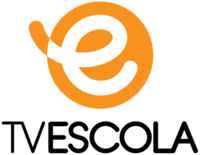 | |
| Type | Broadcast television network |
|---|---|
| Country | |
| Availability | National |
| Founded | June 2, 1995 by Ministry of Education |
| Headquarters | Brasília |
| Owner | Roquette Pinto Foundation |
Launch date | March 4, 1996 |
| Dissolved | April 26, 2022 |
Picture format |
480i (SDTV) 1080i (HDTV) |
Official website | tvescola.mec.gov.br |
TV Escola (literally in English: School TV) is a Brazilian public broadcasting television network created by Ministry of Education of Brazil in 1995. First broadcast in 1996 in a nationwide transmission, it airs exclusively educational programs.
History
The project "TV Escola" was legally approved on June 2, 1995 as part of Strategic Planning of Ministry of Education of Brazil. It was launched by minister Paulo Renato Souza through the Secretariat for Development, Innovation and Educational Evaluation (SEDIAE) on an experimental basis on September 4, 1995 in two schools of Teresina, Piauí. Its first nationwide broadcast occurred on March 4, 1996. On May 27, 1996, the Ministry of Education of Brazil extinguished SEDIAE and created the Secretariat for Distance Education (SEED) to assign TV Escola. [1] Aimed to teachers, it was created to support them as an educational tool, and both to supplement their own training, and for use in their teaching practices. [2] The oldest of two Federal programs created to support technological innovation in Brazil, TV Escola also distributes television sets, videocassette recorders, and satellite dishes to schools. [3] [4]
On December 15, 2003, the then-Minister of Education, Cristovam Buarque, launched the project "TV Escola Interativa" in a partnership with Universidade Mackenzie. [5] The project initially occurred in seven states of Brazil— Acre, Ceará, Espírito Santo, Goiás, Maranhão, Mato Grosso do Sul, and Rio Grande do Sul, distributing in three schools of each state a multimedia kit. [6] The kit allowed to record seven days of programing in CD-ROMs, and to contact TV Escola through telephone and e-mail, allowing the viewer to send suggestions and participate in distance education courses. [5] [6]
Programming
TV Escola's programming is available through satellite television—which includes analog and digital television—, cable television, its official website, and applications for devices with iOS and Android system. [7] It consists of twenty-four hours of educational TV series, cartoons and documentaries divided into five streams; three of them are aimed to teachers of children education, elementary education, and high school, respectively. The other two are "Salto para o Futuro" (lit. "Leap to the Future")—programs used as a support for teacher training courses and college courses—and "Escola Aberta" ("Open School"), which broadcast programs linking school and community. There is also schedules for teaching English, Spanish and French. [8]
References
- ^ "TV Escola: Relatóriio 1996–2002" (PDF) (in Portuguese). Ministry of Education of Brazil. Retrieved March 13, 2014.
- ^ "Sobre a TV Escola" [About the TV Escola] (in Portuguese). TV Escola. Archived from the original on March 13, 2014. Retrieved March 13, 2014.
- ^ World Bank (2003). Rural Poverty Alleviation in Brazil: Towards an Integrated Strategy. World Bank Publications. pp. 210–211. ISBN 9780821352069.
- ^ Mishra, R.C. (2005). Teaching of Information Technology. APH Publishing. p. 113. ISBN 9788176488907.
- ^ a b Cruz, Renato (2008). TV digital no Brasil: tecnologia versus política (in Portuguese). Senac. pp. 170–171. ISBN 9788573597554.
- ^ a b "Escolas estaduais de Goiás recebem TV Escola interativa" [Goiás state schools receive TV Escola Interativa] (in Portuguese). Secretaria de Estado da Educação. December 15, 2003. Retrieved March 13, 2014.
- ^ "Distribuição" [Distribution] (in Portuguese). TV Escola. Retrieved March 13, 2014.
- ^ "Grade de Programação" [Broadcast programming] (in Portuguese). Ministry of Education. Retrieved March 13, 2014.